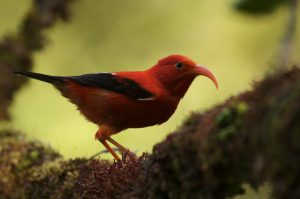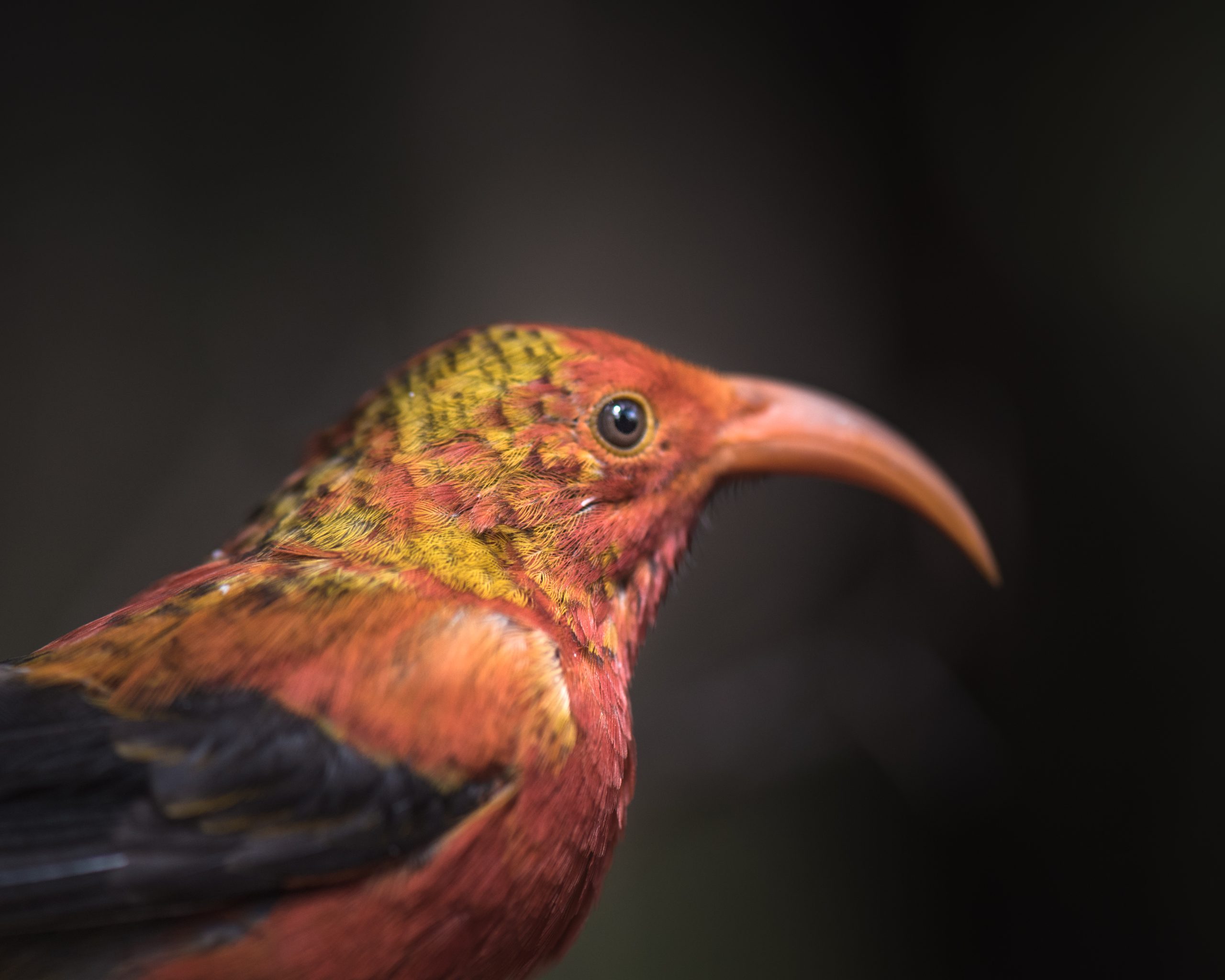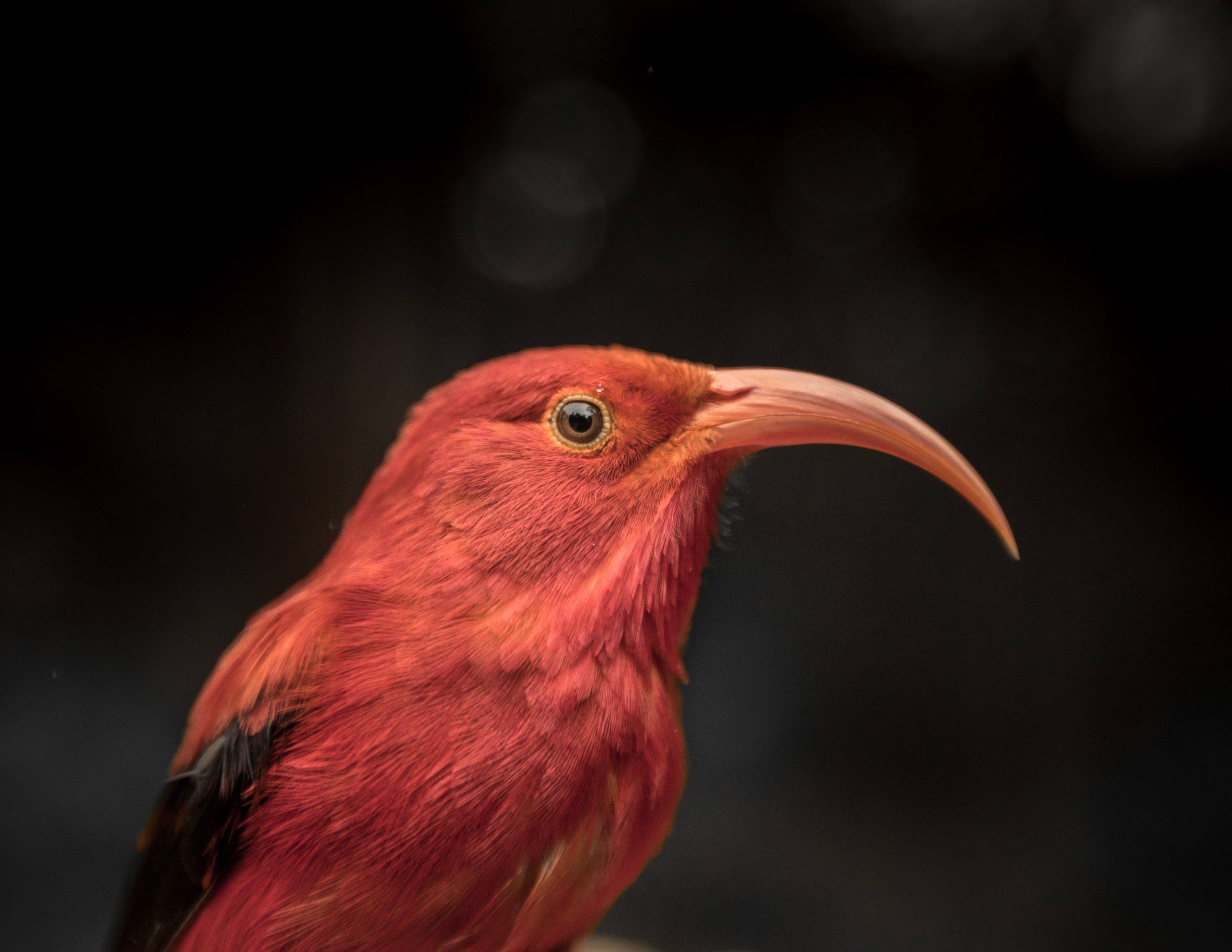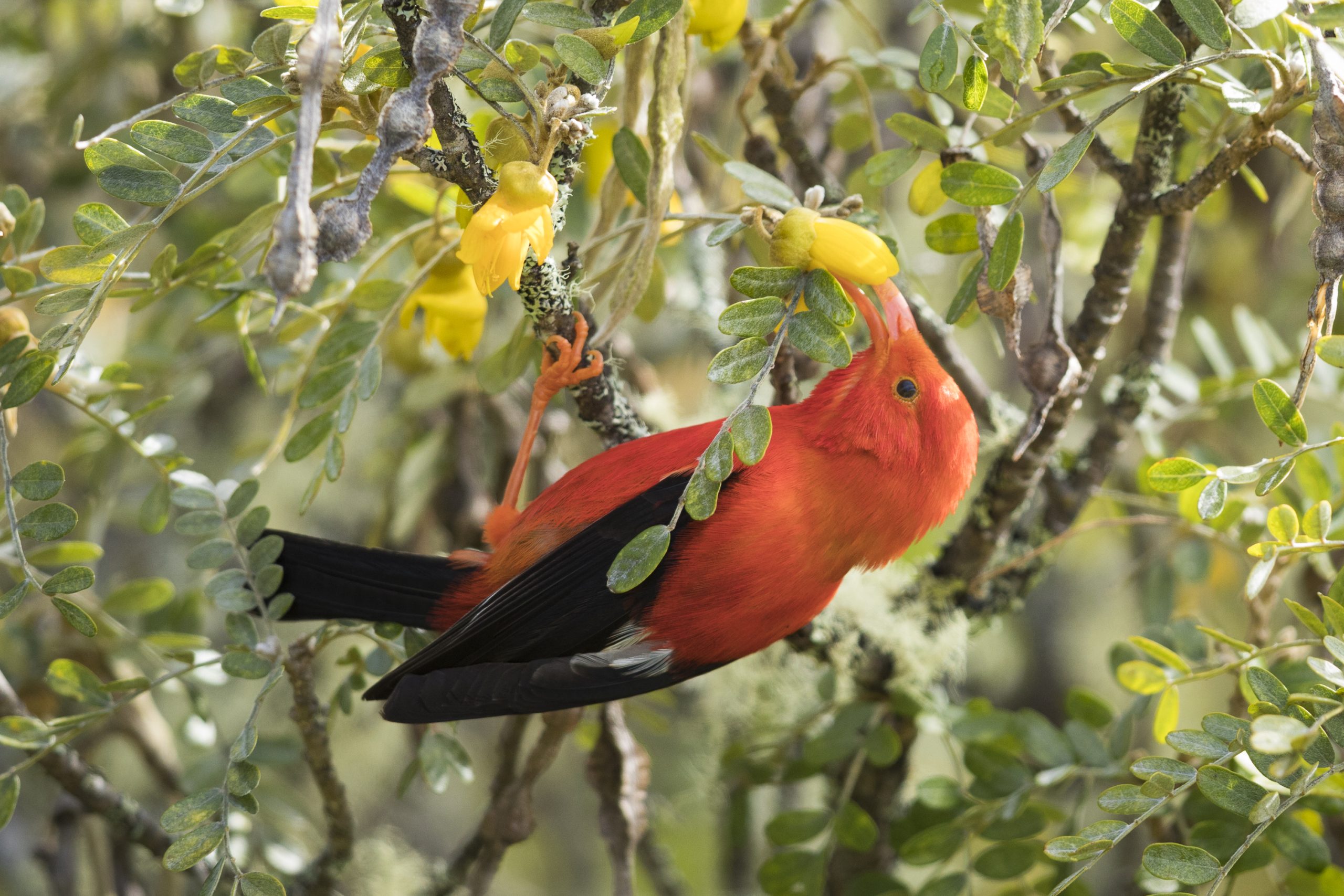ʻIʻiwi

Names
- ʻŌlelo Hawaiʻi: ‘I‘iwi
- Scientific: Drepanis coccinea, Vestiaria coccinea
Song
Conservation Status
- State Listed as Endangered on O‘ahu, Moloka‘i, Lāna‘i
- State Recognized as Endemic
- NatureServe Heritage Rank G4/T1/TH—Apparently Secure/Critically Imperiled Globally on O‘ahu and Moloka‘i/Possibly Extinct on Lāna‘i
- IUCN Red List Ranking—Vulnerable
Species Information

ʻIʻiwi. PC: Lucas Behnke, TNC
The ‘i‘iwi is one of the most beautiful of the extant Hawaiian honeycreepers (Family: Fringillidae). Both males and females are vermillion red, with a black tail and wings, and a long, decurved pink bill. Native Hawaiians created feather capes using hundreds of thousands of ‘i‘iwi feathers; such capes signified power and prestige. Like ‘apapane (Himatione sanguinea), ‘i‘iwi often fly long distances in search of flowering ‘ōhi‘a (Metrosideros polymorpha) trees and are important ‘ōhi‘a pollinators. Their diet consists primarily of nectar from a variety of native and non-native flowers and the presence of non-native flowers may have contributed to increases in some populations. In addition to nectar, ‘i‘iwi also eat small arthropods. Both sexes defend small nesting territories and may defend important nectar resources. Courtship chases and feeding may precede breeding. Nest sites are in terminal branches of ‘ōhi‘a trees and both sexes build the open-cup nest. Only females incubate eggs (typically two) and brood young. Young are mostly provisioned by female; males feed females off the nest. Despite their widespread distribution, little is known about their life history.
Distribution
Occurs above 1,250 meters (4,100 feet) elevation on the islands of Hawai‘i, Maui, and Kaua‘i; and may occur at reduced densities below. Relict populations occur on O‘ahu and Moloka‘i. Historically, ‘i‘iwi were common down to low elevations on all the Main Hawaiian Islands.
Habitat
Mesic and wet forest dominated by ‘ōhi‘a and koa (Acacia koa). Loss and degradation of habitat and high densities of cold-intolerant Culex mosquitoes, an important disease vector, in lowland areas restrict most birds to elevations above 1,250 meters (4,100 feet). Habitats with the highest ‘i‘iwi densities also support kōlea (Myrsine lessertiana), naio (Myoporum sandwicense), and hapu‘u tree ferns (Cibotium spp.). Māmane (Sophora chrysophylla) is common in high-elevation foraging habitat. Although much of the species’ current range is under State or Federal jurisdiction, habitat quality and habitat protection and restoration varies considerably
Threats
Although populations appear stable on the islands of Hawai‘i and Maui, they are likely susceptible to the same factors that threaten other native Hawaiian forest birds, including habitat loss and degradation, predation by introduced mammals, and disease. For ‘i‘iwi, the following is of particular concern:
- Disease. ‘I‘iwi are very susceptible to avian malaria and avian pox. Nine of ten individuals died within 37 days after receiving a single bite from mosquitoes infected with Plasmodium. Individuals infected with pox also are more likely to be infected with malaria. Because the highest points on Moloka‘i and O‘ahu are below 1,250 meters (4,100 feet), this susceptibility likely explains the severe population declines noted on these islands. Foraging movements may increase their exposure to disease.
Plans & Projects
- Maui Forest Bird Recovery Project (MFBRP)
- Kauaʻi Forest Bird Recovery Project (KFBRP)
- Mauna Kea Forest Restoration Project (MKFRP)
Additional Resources
For more information and references visit the DLNR State Wildlife Action Plan factsheets. DOFAWʻs species pages and State Wildlife Action Plan fact sheets are provided for general information and are not meant to be a citable, original source of data. If you are a student, researcher, or writer looking for a citable source, please explore the references below or find other original data sources, rather than citing these webpages. The references below were provided by the authors of the State Wildlife Action Plan fact sheets at the time of drafting:
- Fancy S G, Ralph CJ. 1998. ‘I‘iwi (Vestiaria coccinea). In The Birds of North America, No. 327 (Poole A, Gill F, editors.). Philadelphia, (PA): The Academy of Natural Sciences; and Washington DC: The American Ornithologists’ Union.
- Foster JT, Tweed EJ, Camp RJ, Woodworth BL, Adler CD, Telfer T. 2004. Long-term population changes of native and introduced birds in the Alaka‘i swamp, Kaua‘i. Conservation Biology 18:716-725.
- IUCN Red List of Threatened Species. 2015. Version 2014.3. Available at: www.iucnredlist.org. (Accessed May 2015).
- Paxton, EH, Gorresen, PM, Camp RJ. 2013. Abundance, distribution, and population trends of the iconic Hawaiian Honeycreeper, the ‘I’iwi (Vestiaria coccinea) throughout the Hawaiian Islands: U.S. Geological Survey Open-File Report 2013-1150.
- VanderWerf EA, Rohrer JL. 1996. Discovery of an ‘I‘iwi population in the Ko‘olau Mountains of O‘ahu. ‘Elepaio 56:25–28.



